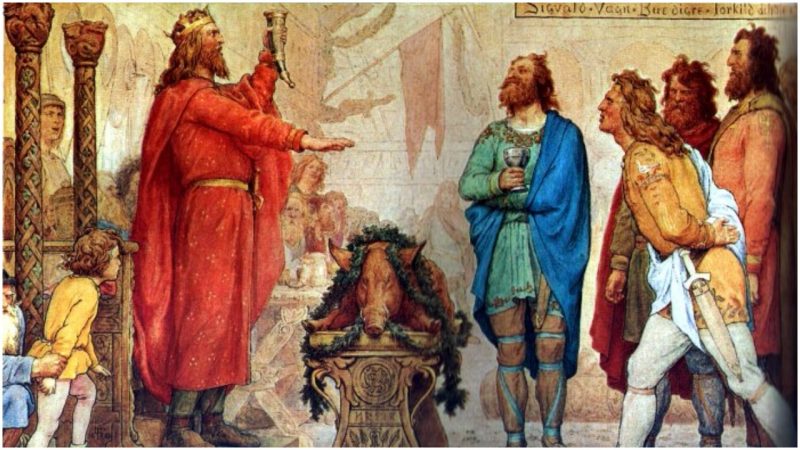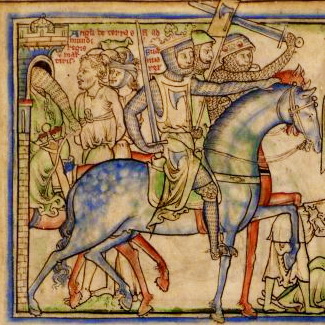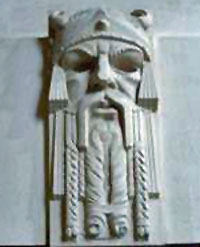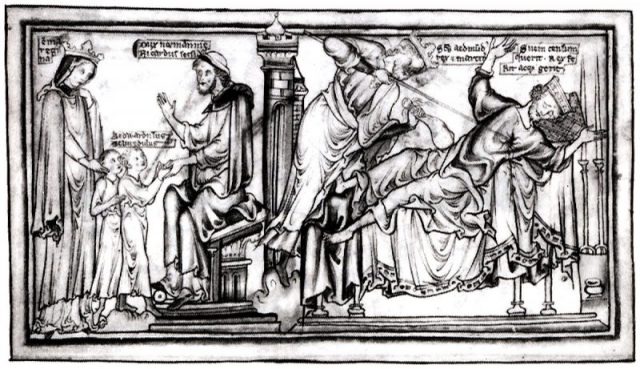
Little is known of the King of Denmark, Sweyn Forkbeard, today, but this Norse monarch was once the King of England as well, albeit for only five weeks, making the small town of Gainsborough in eastern England his capital. One reason for the mystery surrounding him is several conflicting accounts exists, and they describe Sweyn in a different light, depending on the author and his sources.
His life is depicted in several important medieval chronicles outside of Scandinavia, like the 12th century Deeds of the Bishops of Hamburg, written by German scholar Adam of Bremen, or the magnum opus of John of Wallingford, simply titled Chronica. The 13th century English monk, healer, and author tried to capture the history of Sweyns’ conquest of Britain, portraying him as a merciless and godless figure, typical of the image of Northern invaders in early-medieval England.
Sweyn rose to power by seizing the throne of Denmark in the mid-980s, while forcing his father, Harold Bluetooth, to abdicate and flee to exile.
In 1003, he invaded England, following an attack of Danish settlers known as the St Bryce Day Massacre, which came as a reaction to year-by-year harassment of English natives by the Viking pillagers.
Allegedly, Sweyn Forkbeard’s sister, Guldhun, lost her life during the massacre, which had happened in 1002, and retribution was believed to be the main reason for the Danish king’s campaign in England. Some historians doubt this claim, considering Sweyn’s invasion as nothing more than a continuation of yearly raids of the British Isles, which occurred in a 10-year period between 1002 and 1012.

Sweyn Forkbeard invades England
The then-King of England, Aethelred the Unready, who ordered the massacre, quickly lost territories in Wessex and East Anglia to Sweyn Forkbeard, who pillaged the region, sowing fear and death among the local population. Luckily for the English, a terrible famine struck the Norse invaders, forcing them to retreat in 1005.
Following a power vacuum due to the sudden retreat, another Viking leader called Thorkell the Tall took on the role of invader four years later, in 1009–once again scattering English troops and leaving them helpless from the terror that ensued. That’s when Sweyn Forkbeard decided to get back into the game.

Sweyn
He assembled an army and enough money to fund an invasion through the tax-system known as the Danegeld. The Danegeld was more of a racket than a tax system, as it guaranteed certain territories that they wouldn’t be raided if they paid tribute.
What followed was yet another campaign on English soil, led by Sweyn himself, together with his son, Cnut. They landed in Sandwich, and since the rule of Aethelred was collapsing, the local feudal lords bowed to Sweyn and joined him in the following conquest. The same happened with the people of Northumbria and Lindsey, and while Forkbeard’s forces swelled in numbers along the way, the legitimate King was becoming weaker.
In the meantime, Sweyn’s former ally, Thorkell the Tall, defected to the English side, as his own campaign became jeopardized by the Danish King’s new rise to power. In London, the unlikely friends took their stand.

Edmund killing Sweyn. 13th century
Aethelred and Thorkell faced Sweyns’ forces and managed to repel them in a last-stand battle, saving London from pillage and cruel retribution. The Danes retreated and summoned other English provinces to join them. In the meantime, King Aethelred fled to the Isle of Wight, and then to Normandy to join his sons, Alfred and Edward, narrowly escaping death.
Soon after Aethelred’s exile, the citizens of London decided to accept Sweyns’ rule in order to avoid more carnage. On Christmas Day of 1013, Sweyn Forkbeard declared himself the King of England and based the center of his kingdom in Gainsborough.
But fate had other plans for the Danish conqueror. Just five weeks into his rule in England, on February 3, 1014, King Sweyn died and his body was returned to Denmark for burial. Following his death, a struggle arose between the sons; the older son, Harald II, inherited the throne in Denmark, while Cnut, who participated in the English campaign, was declared King of England by Sweyn’s soldiers in 1015.
Thorkell the Tall once again switched sides and offered his support to Cnut, who, in return, declared him the Jarl of East Anglia several years after.
Cnut’s sons, Harold Harefoot and Harthacnut, ruled England for the next 26 years. After Harthacnut, Edward the Confessor retook the throne, returning it to the House of Wessex.
As for Sweyn’s bloodline in Denmark, the current dynasty traces its ancestral origins all the way back to the legendary king. In 1469, one of Forkbeard’s descendants, Margaret of Denmark, married King James III of Scotland, formally introducing the bloodline to British royalty.
